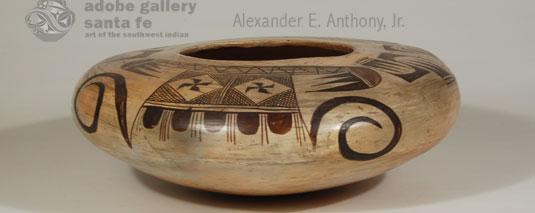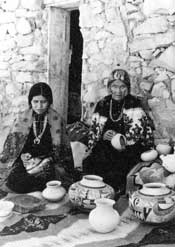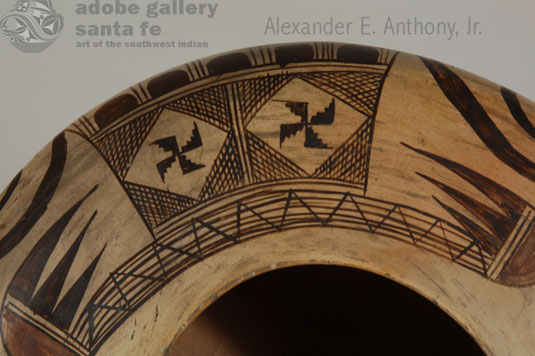Hopi Seed Jar with Whirling Log Design [SOLD]
+ Add to my watchlist Forward to Friend
- Category: Historic
- Origin: Hopi Pueblo, Hopituh Shi-nu-mu
- Medium: clay, pigment
- Size: 4” height x 10-3/4” diameter
- Item # C3944 SOLD

Nampeyo was an artistic genius. She was a Hopi-Tewa living at First Mesa who was going about her duties as a mother and wife, taking care of children, meals and making pottery for use in her home. Her talents in making pottery were early recognized by trader Thomas Keam, who, when he needed someone to make pottery for his business, chose Nampeyo. He recognized her as the best potter at Hopi.
When one looks at this jar, there is no question that she was a great artist. It must qualify as one of the most creative and beautiful jars of the time. One can feel Nampeyo’s presence when rubbing the inside of the rim of the jar where her hands formed the nearly flat top. There are probably fingerprints inside the rim.
This jar is an early one by Nampeyo, when her eyesight was excellent. It dates to circa 1900-1905. She was being encouraged by Keam to copy designs from the prehistoric Sikyatki pottery shards being excavated, but Nampeyo was not into copying anyone else’s work. She used those samples as inspiration for creating her own designs. Picking an element here and an element there from the shards, she placed those ideas into her own designs. It would be difficult to find another potter who could equal her design abilities. She was truly a master at that.
 The vessel shape is another qualifying attribute of Nampeyo’s creativity. This jar has a rounded bottom on which the balance relies on a dime-size spot, yet, the jar sits beautifully and soundly. The underbody swells outward and upward to the widest point and gracefully rolls over and forms a flat top, which does not have the rolled-out rim normally associated with her forms.
The vessel shape is another qualifying attribute of Nampeyo’s creativity. This jar has a rounded bottom on which the balance relies on a dime-size spot, yet, the jar sits beautifully and soundly. The underbody swells outward and upward to the widest point and gracefully rolls over and forms a flat top, which does not have the rolled-out rim normally associated with her forms.
The slip is yellow and the design almost totally dark brown, with just a few areas of red highlights. The primary design may be the earliest version of what became known as the “eagle tail design.” The two whirling log elements are prominently enclosed in boxes surrounded by cross hatching lines. They are the first focus points one sees but then the overall large design captures the viewer.
One must be impressed that Nampeyo applied the design with a brown natural mineral paint and red clay paint using a paint brush made from the leaves of a yucca plant. That was, and still is, the traditional manner of painting pottery. One cannot look at this jar without marveling at the creativity and expertise with which it was made under what must have been primitive circumstances and primitive materials.
Condition: very good condition with expected wear from a century-old jar
Provenance: from the private collection of a gentleman from Texas
Recommended Reading: Canvas of Clay: Seven Centuries of Hopi Ceramic Art by Edwin L. Wade and Allan Cooke
The image above shows Nampeyo of Hano on the right with her daughter Fannie on the left - ca. 1930, courtesy of Rick Dillingham Fourteen Families In Pueblo Pottery.

- Category: Historic
- Origin: Hopi Pueblo, Hopituh Shi-nu-mu
- Medium: clay, pigment
- Size: 4” height x 10-3/4” diameter
- Item # C3944 SOLD



